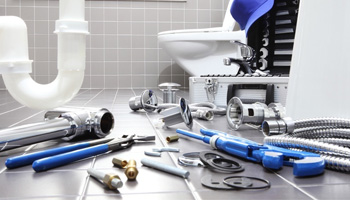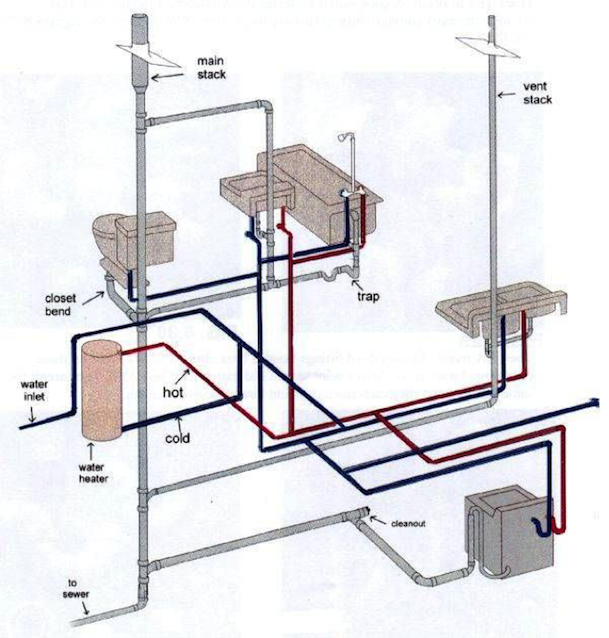Essential Insights About Your Home's Plumbing System Anatomy
Essential Insights About Your Home's Plumbing System Anatomy
Blog Article
Everyone maintains their own unique opinions in relation to The Inner Workings of Your Home's Plumbing.

Understanding just how your home's pipes system functions is crucial for every single house owner. From providing tidy water for alcohol consumption, food preparation, and showering to safely getting rid of wastewater, a properly maintained plumbing system is critical for your household's wellness and comfort. In this comprehensive overview, we'll check out the intricate network that composes your home's plumbing and offer suggestions on upkeep, upgrades, and managing usual issues.
Intro
Your home's pipes system is more than simply a network of pipes; it's an intricate system that guarantees you have access to tidy water and effective wastewater removal. Recognizing its parts and exactly how they work together can aid you avoid costly repairs and make certain whatever runs smoothly.
Standard Components of a Plumbing System
Pipelines and Tubing
At the heart of your pipes system are the pipes and tubes that bring water throughout your home. These can be constructed from various products such as copper, PVC, or PEX, each with its advantages in regards to toughness and cost-effectiveness.
Fixtures: Sinks, Toilets, Showers, and so on.
Fixtures like sinks, bathrooms, showers, and bath tubs are where water is utilized in your house. Comprehending just how these fixtures link to the pipes system helps in detecting problems and preparing upgrades.
Valves and Shut-off Points
Valves regulate the flow of water in your pipes system. Shut-off shutoffs are crucial throughout emergency situations or when you need to make repair services, permitting you to isolate parts of the system without interrupting water circulation to the entire home.
Water System
Main Water Line
The major water line connects your home to the municipal supply of water or an exclusive well. It's where water enters your home and is distributed to different components.
Water Meter and Pressure Regulator
The water meter steps your water use, while a pressure regulator makes sure that water moves at a safe stress throughout your home's plumbing system, preventing damage to pipelines and components.
Cold Water vs. Warm water Lines
Recognizing the difference in between cold water lines, which supply water straight from the main, and warm water lines, which bring warmed water from the water heater, assists in repairing and planning for upgrades.
Water drainage System
Drain Pipes and Traps
Drain pipes lug wastewater away from sinks, showers, and bathrooms to the sewage system or septic tank. Catches avoid sewage system gases from entering your home and also trap particles that could trigger blockages.
Air flow Pipelines
Ventilation pipes enable air right into the water drainage system, avoiding suction that might reduce drainage and trigger catches to vacant. Proper ventilation is necessary for keeping the integrity of your plumbing system.
Significance of Proper Drain
Making certain appropriate water drainage prevents backups and water damage. Consistently cleansing drains and maintaining traps can stop costly repair work and extend the life of your plumbing system.
Water Heating System
Types of Water Heaters
Hot water heater can be tankless or standard tank-style. Tankless heating units heat water on demand, while storage tanks store heated water for immediate use.
Exactly How Water Heaters Link to the Plumbing System
Comprehending exactly how water heaters connect to both the cold water supply and hot water distribution lines helps in diagnosing problems like inadequate hot water or leaks.
Maintenance Tips for Water Heaters
Routinely flushing your water heater to remove sediment, checking the temperature settings, and checking for leaks can extend its lifespan and improve energy efficiency.
Typical Plumbing Issues
Leakages and Their Causes
Leakages can happen as a result of maturing pipelines, loosened installations, or high water pressure. Dealing with leaks quickly protects against water damage and mold growth.
Blockages and Blockages
Obstructions in drains and commodes are commonly triggered by flushing non-flushable things or a buildup of grease and hair. Making use of drainpipe screens and bearing in mind what drops your drains pipes can avoid clogs.
Indications of Plumbing Problems to Expect
Low water pressure, slow-moving drains, foul odors, or abnormally high water costs are indicators of possible plumbing problems that need to be attended to quickly.
Pipes Maintenance Tips
Regular Assessments and Checks
Set up yearly pipes assessments to catch concerns early. Try to find indications of leakages, corrosion, or mineral build-up in taps and showerheads.
DIY Upkeep Tasks
Easy tasks like cleansing faucet aerators, checking for commode leaks making use of dye tablet computers, or protecting exposed pipes in cool climates can prevent significant plumbing concerns.
When to Call an Expert Plumbing
Know when a plumbing concern needs professional experience. Attempting complex repairs without correct knowledge can result in even more damage and greater repair work expenses.
Updating Your Plumbing System
Factors for Upgrading
Updating to water-efficient fixtures or replacing old pipes can enhance water quality, minimize water expenses, and raise the value of your home.
Modern Pipes Technologies and Their Benefits
Discover technologies like wise leakage detectors, water-saving toilets, and energy-efficient hot water heater that can save money and decrease ecological impact.
Cost Factors To Consider and ROI
Compute the upfront expenses versus long-term cost savings when taking into consideration plumbing upgrades. Numerous upgrades spend for themselves through decreased energy costs and less repair work.
Environmental Effect and Preservation
Water-Saving Fixtures and Home Appliances
Setting up low-flow taps, showerheads, and toilets can considerably decrease water use without giving up performance.
Tips for Decreasing Water Usage
Basic habits like repairing leaks quickly, taking much shorter showers, and running complete tons of washing and recipes can conserve water and lower your utility expenses.
Eco-Friendly Pipes Options
Take into consideration lasting pipes materials like bamboo for flooring, which is durable and environment-friendly, or recycled glass for kitchen counters.
Emergency situation Readiness
Actions to Take Throughout a Pipes Emergency situation
Know where your shut-off shutoffs lie and just how to switch off the water supply in case of a burst pipe or major leak.
Significance of Having Emergency Get In Touches With Helpful
Maintain get in touch with information for regional plumbings or emergency situation solutions conveniently offered for fast action during a plumbing crisis.
DIY Emergency Fixes (When Appropriate).
Short-term fixes like using duct tape to patch a dripping pipeline or putting a bucket under a trickling tap can decrease damages till an expert plumbing technician shows up.
Final thought.
Comprehending the composition of your home's plumbing system equips you to preserve it efficiently, conserving money and time on repair services. By following normal upkeep regimens and staying informed about modern-day pipes innovations, you can guarantee your pipes system runs effectively for years to come.
HOW YOUR PLUMBING SYSTEM WORKS
Which Pipes Do What?
Blue lines = fresh water supply entering the building
Red lines = hot water supply entering the building
Grey lines = pipes carrying waste away from the building and venting pipes carrying gases away from the building (through the roof)
YOUR MAIN PLUMBING SYSTEMS
There are two main plumbing systems that support your home s basic plumbing needs one that brings clean water into your home, and one that sends dirty water away from your home. Connected to the toilet, bath, shower, and other faucets in your home, these two systems keep your water flowing in the right directions.
ACCESSING FRESH WATER
Fresh and clean water is brought into your home through the main water supply line . Filtered through one pipe, this water is pressured to flow into the various fixtures in your home at any given time.
This water can be sourced from a well located on your property, a pond or river (mostly cottages), or, as in most cases, from the city s municipal water treatment centre. However, it is important to note that water that is untreated, such as the water siphoned from ponds or rivers, may not be safe to drink. Personal water supplies always need to be treated for hardness and contaminants before consumed.
MUNICIPAL WATER SUPPLIES
Improve taste and odour
Remove sediment
Eliminate hardness
Reduce chlorine
COLD WATER SUPPLY VS. HOT WATER SUPPLY
Cold water flows into your home or building through the service line, which then distributes hot or cold water to your fixtures. This line is most commonly run through a central column that runs floor to floor. Hot water runs in short and straight pipes as the longer the pipeline, the more heat that will be lost in the transfer. Having shorter pipes also allows residents to access hot water more quickly.
WASTE WATER SYSTEM
Your wastewater system is divided into two parts pipes that send wastewater away from your home and venting pipes that send sewer gas away from your home. Sewage water travels through pipes that flush the water and waste towards local sewers that are operated and managed by your city or town. Most sewer systems rely on gravity to move the wastewater to where it needs to go.
The further away from your toilet or sink, the larger wastewater pipes become. This allows for waste to be disposed of from various parts of your home or business at once without pipe blockages. The angle and flow of these pipes are also essential for keeping your waste pipes clear of build up.
https://harrisplumbing.ca/how-your-home-plumbing-system-works/

HOW YOUR PLUMBING SYSTEM WORKS
Which Pipes Do What?
YOUR MAIN PLUMBING SYSTEMS
There are two main plumbing systems that support your home s basic plumbing needs one that brings clean water into your home, and one that sends dirty water away from your home. Connected to the toilet, bath, shower, and other faucets in your home, these two systems keep your water flowing in the right directions.
ACCESSING FRESH WATER
Fresh and clean water is brought into your home through the main water supply line . Filtered through one pipe, this water is pressured to flow into the various fixtures in your home at any given time.
This water can be sourced from a well located on your property, a pond or river (mostly cottages), or, as in most cases, from the city s municipal water treatment centre. However, it is important to note that water that is untreated, such as the water siphoned from ponds or rivers, may not be safe to drink. Personal water supplies always need to be treated for hardness and contaminants before consumed.
MUNICIPAL WATER SUPPLIES
COLD WATER SUPPLY VS. HOT WATER SUPPLY
Cold water flows into your home or building through the service line, which then distributes hot or cold water to your fixtures. This line is most commonly run through a central column that runs floor to floor. Hot water runs in short and straight pipes as the longer the pipeline, the more heat that will be lost in the transfer. Having shorter pipes also allows residents to access hot water more quickly.
WASTE WATER SYSTEM
Your wastewater system is divided into two parts pipes that send wastewater away from your home and venting pipes that send sewer gas away from your home. Sewage water travels through pipes that flush the water and waste towards local sewers that are operated and managed by your city or town. Most sewer systems rely on gravity to move the wastewater to where it needs to go.
The further away from your toilet or sink, the larger wastewater pipes become. This allows for waste to be disposed of from various parts of your home or business at once without pipe blockages. The angle and flow of these pipes are also essential for keeping your waste pipes clear of build up.
https://harrisplumbing.ca/how-your-home-plumbing-system-works/
I'm certainly very occupied with Understanding Your Home's Plumbing Anatomy and I hope you enjoyed reading our post. So long as you appreciated our blog entry kindly don't forget to share it. Thank-you for going through it.
Get A Quote Report this page